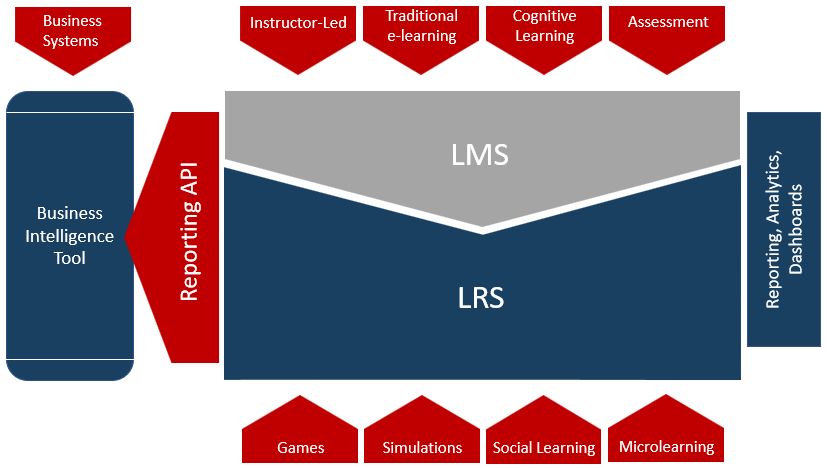
With the spread of xAPI, an LMS can no longer be a stand-alone silo. It must actively participate in a Learning Ecosystem.
What is a Learning Ecosystem Platform?
It is now widely accepted that most learning occurs outside the LMS. While it is true that the LMS captures your instructor-led learning and your e-learning, much informal learning occurs outside the system. Consider experiential learning, learning games, virtual worlds, social learning, micro-learning, simulations…are you capturing those learning experiences? xAPI makes it possible to capture learning that occurs outside your LMS. In the modern Learning Ecosystem, we see the Learning Record Store (LRS) as the “single source of truth” for learning activities. The LMS should be an active participant in the Ecosystem.
Elements of a Learning Ecosystem
At RISC, we believe true support of xAPI by a Learning Ecosystem Platform must include the following elements.
- A conformant LRS.
There’s a list; you can check it. - An LRS that accepts and returns statements that are generated outside the LMS.
This seems obvious, since one of the advantages of xAPI is that you don’t need to launch training from an LMS in order to track it. Unfortunately, it is not so obvious to all LMS providers. (see Why Conformance Matters). - An LMS that is an Activity Provider
An LMS should not exist in an isolated tower, separate from the LRS. It should actively participate in your Learning Ecosystem by contributing statements to the LRS. - Reporting across the LMS & LRS
The LMS contains a lot of “non-training” data this is not available in the LRS. This is because the LRS was designed to be a learning activity stream and was not intended to replace all functions of an LMS. For example, the LMS may have data about organizational structure for “roll-up” reporting. It is critical to the ecosystem that such data be combined with LRS data in order to produce enterprise reporting.

Figure 1 – The VTA Learning Ecosystem Platform includes the LMS, the LRS, and reporting that spans both the LMS and the LRS.
LMS as Activity Provider in the Ecosystem
Note: VTA is the acronym for RISC’s LMS, the Virtual Training Assistant. As an active participant in the Learning Ecosystem, VTA makes many statements about student activity. Consider the following example: A student takes a test in VTA. As you may know, VTA stores each test question and the student’s answer for all tests and can perform Item Analysis on test questions. But what if VTA did not write that information to the LRS? In that case, data about test questions delivered by VTA would be in the VTA database, while test questions delivered by e-learning content would be stored in the LRS. There is no single source of truth. For this reason, VTA writes all test questions to the LRS in addition to the VTA database.
VTA writes a lot of data to the LRS, including:
- Registrations
- Test questions
- Content launches
- Document launches
- Resource access
- Competency Assessments
- Forum contributions
- Spaced Learning
- Flash Cards
- SCORM data
Reporting in the Learning Ecosystem
There is an important advantage in the Ecosystem when your LRS is built-in to your LMS; Reporting. Your LMS already contains organizational data about your students. For example, the LMS knows who supervises a student. It knows their department and region, their job title, their hire date, etc. As a result, you can have roll-up reporting. For example, a supervisor can have xAPI dashboards that include only their direct reports. With a “pure” LRS, this is not possible. With an integrated system you can roll-up reporting to all levels of the organization while enforcing security regarding data access.
Business Intelligence Tool
Many Learning Ecosystem designs recommend you should write business data to xAPI, and you can certainly do that. However, this requires getting data out of all your business systems, converting it to xAPI, and sending it to the LRS. Depending on your environment, this may not be possible. You may find it easier to combine business and learning data using an external Business Intelligence (BI) tool. If you are in a large organization, it is highly likely that you already have access to a BI Tool, such as Microsoft Power BI. Most commercial BI tools will import data from a huge variety of sources, such as SQL and Oracle databases, Excel and systems like Salesforce and Sharepoint.
The VTA Learning Ecosystem can act as an input to your BI tool, allowing you to easily combine business and learning data for management reporting. Imagine combining data about sales training and sales results in a single dashboard. You could truly measure your impact on the business!
In most cases, RISC recommends that you NOT include business data in your LRS. Why? There are several reasons:
- Duplicating data often leads to messy, inaccurate data.
- xAPI data is “immutable”, meaning that it cannot be changed. If something changes in your data you can “void” previous statements and then write new ones.
- As previously mentioned, most BI Tools have existing integrations with business data systems. Why re-invent the wheel?
Summary
With our Learning Ecosystem Platform you have a data stack to capture all learning activities. Use the LRS to capture “non-traditional” learning such as games, virtual worlds, social learning, micro-learning and simulations. Use the LMS to capture instructor-led activities, traditional e-learning and compliance records. The Ecosystem will provide you with a common source for reporting across the LRS and LMS.
